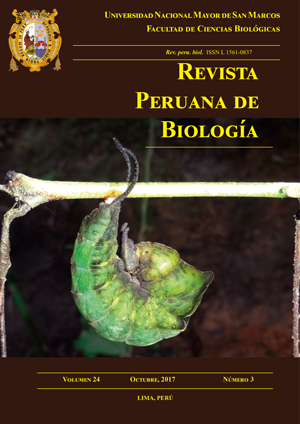Mutations in the Determining Region of Quinolone Resistance (QRDR) of the gyrA gene of Neisseria gonorrhoeae present in clinical samples of men who have sex with men
DOI:
https://doi.org/10.15381/rpb.v24i3.13905Keywords:
Neisseria gonorrhoeae, MSM, gene gyrA, resistance to quinolonesAbstract
Neisseria gonorrhoeae resistant to quinolones (QRNG) becomes a very important problem in public health due to the development of rapid resistance to quinolones, which is why the WHO recommends reinforcing antimicrobial resistance monitoring to guide treatment. In Peru there are few reports on QRNG surveillance and still less work related to mutation patterns. This study aims to find mutations in the Determinant Region of Quinolone Resistance (QRDR) of the gyrA gene of N. gonorrhoeae from 1096 clinical samples of urine and swabs from 367 men who have sex with men (MSM) collected during the period 2012-2013. We detected 58 N. gonorrhoeae positive samples in 45 MSM by means of the APTIMA Combo 2 assay, and 11 QRNG positive samples of 11 MSM by Real Time PCR. The quinolone-resistant bacteria were analyzed by sequencing and we identified that the frequent mutation pattern was the double mutation of Ser-91 to Phe and Asp-95 to Gly in the QRDR of the gyrA gene. In conclusion, these double mutations in the QRDR sequence of the gyrA gene would indicate the presence of N. gonorrhoeae with quinolone resistant phenotype in clinical samples of MSM from Lima-Peru, noting that this is the first study done in Peru on this high population risk.Downloads
Downloads
Published
Issue
Section
License
Copyright (c) 2017 Liz Sánchez Palencia, José Acosta Cáceres

This work is licensed under a Creative Commons Attribution-NonCommercial-ShareAlike 4.0 International License.
AUTHORS RETAIN THEIR RIGHTS:
a. Authors retain their trade mark rights and patent, and also on any process or procedure described in the article.
b. Authors retain their right to share, copy, distribute, perform and publicly communicate their article (eg, to place their article in an institutional repository or publish it in a book), with an acknowledgment of its initial publication in the Revista Peruana de Biologia.
c. Authors retain theirs right to make a subsequent publication of their work, to use the article or any part thereof (eg a compilation of his papers, lecture notes, thesis, or a book), always indicating its initial publication in the Revista Peruana de Biologia (the originator of the work, journal, volume, number and date).


















